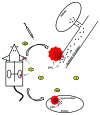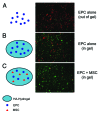Delivery of EPC embedded in HA-hydrogels for treatment of acute kidney injury
- PMID: 23507925
- PMCID: PMC3732320
- DOI: 10.4161/biom.23284
Delivery of EPC embedded in HA-hydrogels for treatment of acute kidney injury
Abstract
Adoptive transfer of stem cells has shown potential as an effective treatment for acute kidney injury (AKI). The current strategy for adoptive transfer of stem cells is by intravenous injection. However, this conventional method of stem cell delivery is riddled with problems causing reduced efficacy of the therapeutic potential of delivered stem cells. This review summarizes the recent advancements in an alternative method of stem cell delivery for treatment of AKI, embedding stem cells in hyaluronic acid (HA-) based hydrogels followed by their implantation. Furthermore, one stem cell type in particular, endothelial progenitor cells (EPC), have shown remarkable therapeutic benefits for treatment of AKI when delivered by HA-hydrogels. The review also summarizes the delivery of EPC by HA-hydrogels in the setting of AKI.
Keywords: Adriamycin-induced kidney injury; acute kidney injury; endothelial progenitor cells; endotoxemia; hyaluronic acid based hydrogels; sepsis; stem cell therapy.
Figures


Similar articles
-
Hydrogel-embedded endothelial progenitor cells evade LPS and mitigate endotoxemia.Am J Physiol Renal Physiol. 2011 Oct;301(4):F802-12. doi: 10.1152/ajprenal.00124.2011. Epub 2011 Jul 20. Am J Physiol Renal Physiol. 2011. PMID: 21775481 Free PMC article.
-
The Secretome of Hydrogel-Coembedded Endothelial Progenitor Cells and Mesenchymal Stem Cells Instructs Macrophage Polarization in Endotoxemia.Stem Cells Transl Med. 2015 Jul;4(7):852-61. doi: 10.5966/sctm.2014-0111. Epub 2015 May 6. Stem Cells Transl Med. 2015. PMID: 25947337 Free PMC article.
-
Injectable shear-thinning hydrogels used to deliver endothelial progenitor cells, enhance cell engraftment, and improve ischemic myocardium.J Thorac Cardiovasc Surg. 2015 Nov;150(5):1268-76. doi: 10.1016/j.jtcvs.2015.07.035. Epub 2015 Jul 17. J Thorac Cardiovasc Surg. 2015. PMID: 26293548 Free PMC article.
-
The use of hydrogels for cell-based treatment of chronic kidney disease.Clin Sci (Lond). 2018 Sep 16;132(17):1977-1994. doi: 10.1042/CS20180434. Print 2018 Sep 14. Clin Sci (Lond). 2018. PMID: 30220651 Review.
-
Hyaluronic acid hydrogels, as a biological macromolecule-based platform for stem cells delivery and their fate control: A review.Int J Biol Macromol. 2021 Oct 31;189:554-566. doi: 10.1016/j.ijbiomac.2021.08.140. Epub 2021 Aug 27. Int J Biol Macromol. 2021. PMID: 34437920 Review.
Cited by
-
In Situ Tissue Regeneration of Renal Tissue Induced by Collagen Hydrogel Injection.Stem Cells Transl Med. 2018 Feb;7(2):241-250. doi: 10.1002/sctm.16-0361. Stem Cells Transl Med. 2018. PMID: 29380564 Free PMC article.
-
Experimental renal progenitor cells: repairing and recreating kidneys?Pediatr Nephrol. 2014 Apr;29(4):665-72. doi: 10.1007/s00467-013-2667-5. Epub 2013 Nov 13. Pediatr Nephrol. 2014. PMID: 24221350 Review.
-
Endothelial progenitor cells for fabrication of engineered vascular units and angiogenesis induction.Cell Prolif. 2024 Sep;57(9):e13716. doi: 10.1111/cpr.13716. Epub 2024 Jul 25. Cell Prolif. 2024. PMID: 39051852 Free PMC article. Review.
-
Concise Reviews: Stem Cells and Kidney Regeneration: An Update.Stem Cells Transl Med. 2019 Jan;8(1):82-92. doi: 10.1002/sctm.18-0115. Epub 2018 Oct 9. Stem Cells Transl Med. 2019. PMID: 30302937 Free PMC article. Review.
References
-
- Park HC, Yasuda K, Ratliff B, Stoessel A, Sharkovska Y, Yamamoto I, et al. Postobstructive regeneration of kidney is derailed when surge in renal stem cells during course of unilateral ureteral obstruction is halted. Am J Physiol Renal Physiol. 2010;298:F357–64. doi: 10.1152/ajprenal.00542.2009. - DOI - PMC - PubMed
Publication types
MeSH terms
Substances
Grants and funding
LinkOut - more resources
Full Text Sources
Other Literature Sources
